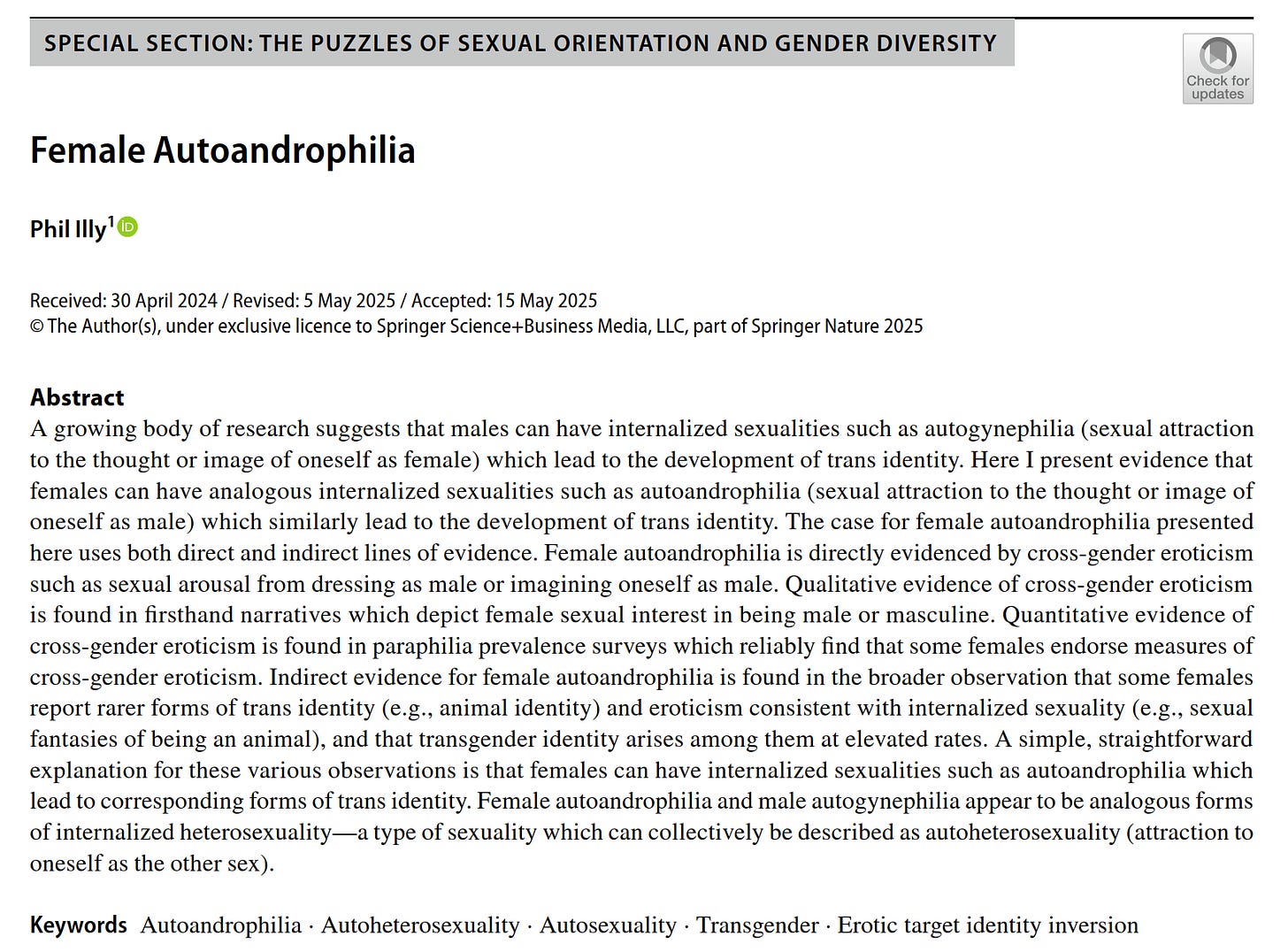Female Autoandrophilia
the current best paper on the subject
It is not yet generally accepted among leading sexologists that female autoandrophilia exists, nor that it is a major contributor to gender dysphoria and transsexualism in females. I think they are overlooking the primary cause of FTM transsexualism, so I wrote a paper for publication in the best sexology journal, Archives of Sexual Behavior.
“Female Autoandrophilia” is currently the best peer-reviewed paper on female autoandrophilia.
I say this not to brag, or because I think this paper is perfect, but rather for a simpler, sadder reason: this is the first peer-reviewed paper on female autoandrophilia. That’s just how neglected this subject is.
In “Female Autoandrophilia”, I put forward a case for the existence of female autoandrophilia with three lines of evidence:
Published narratives and case studies which show females who report sexual interest in being masculine or male.
Surveys that investigate the prevalence of paraphilias consistently find that some females endorse measures of cross-gender eroticism (e.g., arousal from the idea of being male, arousal from crossdressing).
Some of the people who report rarer kinds of dysphoria or trans identity are female, and transgenderism occurs among them at elevated rates.
These first two are direct indicators that autoandrophilia likely exists. Males who report sexual interest in being the other sex do so because of autogynephilia, so when females report sexual interest in being the other sex, the most straightforward and obvious explanation is that they are experiencing an analogous phenomenon (i.e., autoandrophilia). This logic and reasoning here is pretty clear and unambiguous, so I won’t elaborate on it further here.
The third line of evidence for female autoandrophilia is indirect but has a broader implication: females can experience erotic target identity inversion. Some of the people who experience body integrity dysphoria are female (and indeed, some of them report sexuality related to it). Likewise, some females participate in the Adult Baby/Diaper Lover subculture in which people commonly eroticize wearing diapers or roleplaying as a child. Similarly, females also belong to the otherkin and therian subcultures. Studies and community surveys of these populations indicate that people who report these rarer types of trans identity and dysphoria also experience gender dysphoria and transgender identity at elevated rates. This demographic overlap between transgender identity and rarer, non-gendered forms of trans identity occurs in both sexes. This is exactly what you’d expect if all these populations are the result of erotic target identity inversion.
I felt it was important to include evidence and arguments in favor of the broader notion that females can experience erotic target identity inversion because the fact that some females report sexual arousal from the idea of being male is not convincing enough for some people. Maybe they think females simply don’t get paraphilias and therefore female autoandrophilia doesn’t exist. Or maybe they think that behaviors and feelings which might seem like autoandrophilia on the surface are actually just an eroticized way of escaping patriarchy. Whatever their reasoning, I think people who deny the existence of female autoandrophilia and its relevance to FTM transsexualism are incorrect, and I would like them to explain why some females seem to have the rarer kinds of erotic target identity inversion based on internalized sexual attraction to disabled people, children, or animals, yet somehow do not ever experience an internalized variant of heterosexuality—the most common form of sexuality.
In the future, I may write a summary of the paper and post it here, but for now I just wanted to let you know the paper exists and encourage you to read it.
Feel free to share the PDF with others via emails, DMs, discord servers, forums, etc. More people need to know about female autoandrophilia.


